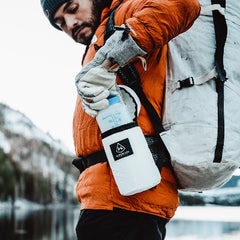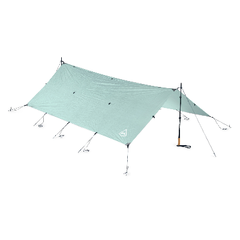When I moved to Idaho, I picked up the gazetteer’s map and almost immediately noticed the dashed black line running through its pages. The arc delineated the Idaho Centennial Trail, an 850-mile trek from Nevada to Canada… I filed it away in my black book of to-do’s.
As I began to explore my new home, that black line continued to creep into my maps. The Sawtooths, The Frank, the Owyhees… there it was. The Centennial trail was devised to cut through the best of the State, and I didn’t have the time–or the urge–to hike it all. Studying the maps, I noticed key rivers flowed north before turning west to the Columbia. The wheels began to take traction. Why not boat the rivers, then cycle or pack between the drainages?
 So I devised a plan that would move us through a northerly route in an expeditious way. Success hinges on embracing “fast and light,” using featherweight kits with minimal supplies. But it’s not enough to just have the latest carbon and cuben fiber. It’s critical to be trained in body and mind to go fast, smart, and ultimately be smart enough to go light.
So I devised a plan that would move us through a northerly route in an expeditious way. Success hinges on embracing “fast and light,” using featherweight kits with minimal supplies. But it’s not enough to just have the latest carbon and cuben fiber. It’s critical to be trained in body and mind to go fast, smart, and ultimately be smart enough to go light.
My adventure background stems from mountaineering and distance running, where training has always been a core part of the journey. It’s a habit woven pretty tightly into my fabric. So when someone asks how I get in shape for an endeavor like this, I usually reply that I try not to get out of shape. But the Idaho Traverse averages 50-60 miles a day, with monster days on the bike, requiring me to move new muscles for longer duration. I laid out a plan to build up speed, muscle, and endurance. My wife insisted on a spin bike, which was probably a game-saver during this year’s wet winter and spring. (The flip side is I have liters of my soul stained into the basement grout.) As we moved into summer, I focused primarily on longer endurance riding.
Fall/Winter
Tuesday/Thursday: I would do a lactic threshold run or ride, followed by 20 minutes of weights–working mostly core and upper body to balance the load on the legs.
Sundays: I’d either sit on the spin bike or run for 2-3 hours.
Monday/Fridays: 1.5 hours on the spin bike or running.
Spring/Summer
The Boise foothills are a fantastic playground to train in. We have over 130 miles of single track which I’m able to access right out the back door of my office or 5 minutes from home. Go a little longer and I can ride these trails to the backcountry fire roads, the same system that will take us all the way to Canada.
During the week: I dropped the weights and held on to the lactic thresholds as much as I could, which was usually one tempo ride a week. In June I transitioned to mostly 2-3 hour daily rides or runs. To maximize time, I’d sometimes divide workouts into morning runs and lunch-hour rides.
Weekend: I’d take in an early long ride on the local fire roads. One of my repeated routes was a 60-mile loop with 7,000 feet of climbing (or 5-6 hours in the saddle). If you can ride that long (and stay hydrated and fed), you can ride all day.

Gear
While the Idaho Traverse is a multi-sport endeavor, we can divide our route into cycling and pack-rafting legs (which also includes backpacking). But our method requires us to be able to leverage the same gear during either of these legs. A streamlined kit is paramount.

Packs. We had our pick and chose to use Hyperlite’s Windrider pack. At 40 liters, it’s the perfect size. While cycling, we’ll put our ‘puffy’ items in the pack. It compresses well, doesn’t round out and stays clear of helmets. The pack is well taped and we’ve seam gripped exposed seams. With a roll top, it’s virtually a drybag; it should keep our gear plenty dry while rafting. And when we need to hike, its side pockets hold paddles tight and the large kangaroo pocket in back allows wet gear to dry out or the solar panel charging our electronics.
Clothing. Clothing can be divided in to clothing worn on the go, and clothing incorporated into our sleep system.
Base layer: While on the go, we’ll each have two pairs of shorts each, one for cycling, one for hiking and rafting—both are a Lycra, bike-fit type short. We’ll use one synthetic short sleeve shirt each for both cycling and hiking. Instead of bringing long sleeve shirts or tights, we’ll use cycling ‘sleeves’ and leg warmers, which offer greater warmth when we need them, and more flexibility across disciplines.
Wind layer: In addition to shoes and our ‘super hero-like’ base layer, Salomon provided a great 5oz wind jacket. It’s ideal for riding during the twilight hours and I’ll likely sleep in it.
Rain gear: Eddie Bauer is our primary sponsor and has made a big reentry into mountaineering with their First Ascent line. For rain gear, we’ll be using Eddie Bauer’s BC200 jacket (10 oz). I’m supplementing the kit with a pair of Patagonia Grade VI waterproof pants (6 oz).
Footwear: We’ll be using Salomon XA Pros for rafting and hiking, cycling shoes, and two pairs of wool running socks.
Head and handwear: My all around head wear is a buff—which works great in both hot and cold conditions, and a pair of soft shell gloves for chilly morning riding conditions. It’s Idaho in summer, so it will be hot and dry for the most part, but I’m throwing in a pair of plastic medical gloves for dire, wet situations.
All counted, our entire clothing kit weighs 4.5 pounds.
Sleep System / Insulated clothing. It’s no secret that if you wear your clothes to bed, you’ll stay warmer. A key part of our sleep system is integrating Eddie Bauer’s insulation line into our sleep system. I’ll be using a Women’s XL Downlight Hoodie (13 oz. It was a hot item this season and sold out in men’s sizes). Chris chose to go with synthetic and will be using the Eddie Bauer Igniter jacket (20 oz). Instead of sleeping bags, we will both carry a 1/2 quilt by Nunatak (9 oz), upgraded to 975 fill power. We’ll use torso-length Neoair thermo-rest pads (9 oz) with our dry bags and packs as supplementary ground cover.
Shelter. We worked with the team at Hyperlite Mountain Gear to develop a three-person shelter that would work for pack-rafting, cycling, or backpacking. We can readily pitch the tent using our 4-piece paddles, poles, or even our bikes. Our original team had three members; one pulled out after we had prototyped the shelter. But the extended space is ideal for pack-rafting: if you want to use your rafts as pads, two rafts readily fit under its walls. The shelter weighs 25 oz.

Cooking. Taking a page from Andrew Skurka, I built a cat food-can alcohol stove. It weighs virtually nothing (like 0.3 oz). Filled, this stove quickly fired up and boiled 0.8L of water in 5 minutes and then burned another 7 minutes. It only needs an ounce of alcohol to boil water. We’re bringing an 0.85 L titanium pot and an 0.7 L titanium pot. Both of us will use a titanium spork.
We’ll each carry 2-liter and 3-liter MSR bladders, providing backup should one fail, and 5 full liters of water to cross the Owyhee desert.
Device vice. Getting sponsored to go light has its payback, and it’s all in this line item. We’re documenting the trip with RAW images and HD video. My primary camera will be a Sony Nex 5 (love this), but we’ll also bringing two GoPro helmet cameras to capture on-the-go video. We’re bringing a SPOT connect to track our route and share quick updates along the way, and my satellite phone looks like something Tubbs would brandish on the South Beach strip. We’ll be charging it all with a solar panel.
Cycling. With epics like “Ride the Divide” and adventure races, adventure cycling has embraced ultralight practices. We’ll be using the same gear during the cycling legs, just carrying more of it on our frame bag system. To keep most of the weight out of our packs, we’ll use a handlebar bag, a large seat bag, and a “gas tank” bag that rides over the top bar. In addition, I’ll be using a small bag that fits inside the frame geometry, keeping the center of gravity tight. All of our bike gear will be shuttled around the Frank Church and Selway-Bitterroot wildernesses, so that we can swap boats for bikes and pedal onward to Canada.
<
Pack-rafting. This fringe sport is more than strapping a kiddie pool to your hindquarters; it’s blossomed into an active community of adventurers, seeking to cover more miles through wild areas. While we expect to hike between 30 miles a day, we can paddle between 30-50 miles a day with much less effort. The entire kit–paddle, boat, spray skirt–weighs about 6 pounds. We won’t skimp on the PFD, though. If the Bruneau is running below 500cfs, we’ll ship our boats to a ranch sitting at the edge of the Frank and exchange them for our bikes in Lowell, 250 miles later. If the Bruneau runs above 500cfs, we’ll run the Bruneau and then carry the boats with us to the Frank.
Food. Chris found out that he has a gluten intolerance, which goes directly against my strict complex carbohydrate and saturated fat diet. Fortunately, Chris is a professor of physiology and has had many students who have graduated and moved onto interesting careers…like endurance athlete nutritionists. Big shout-out to Sarah Weber for putting together a creative solution for our diet dilemma. In general, we’ll be eating calorie-dense foods that have high calorie-to-ounce ratios: think nuts, nut butter, dried soups, dried potatoes, hummus, quinoa, and halvah.
All together, we plan to carry no more than 35 lbs at any one time. We’ve strategically arranged for caches every 200-300 miles so we can travel 50-75 miles per day, which allows us to travel with 4 days of supplies for every block of travel.
– Steve Graepel
The team at Hyperlite Mountain Gear would like to wish the best of luck to Steve and Chris on this traverse. We are excited to follow Steve and Chris’ progress and to see photos and videos of their expedition. We are so happy to be be able to sponsor this team with companies like Eddie Bauer, Patagonia and Solomon. Steve and Chris are scheduled to depart Saturday, July 23.
The post Steve Graepel and Chris Minson, on an 850 Mile Idaho Traverse appeared first on Hyperlite Mountain Gear Blog.















